INTRODUCTION
Outbreaks of infectious disease associated with sporting activity have been widely reported, most commonly due to direct person-to-person transmission of infections such as herpes simplex and methicillin-resistant Staphylococcus aureus [Reference Turbeville, Cowan and Greenfield1]. Common source outbreaks are less common, but have resulted from communal use of equipment, facilities and exposure to the environment [Reference Turbeville, Cowan and Greenfield1, Reference Young2]. Zoonoses are uncommon in this setting. Two outbreaks of leptospirosis have been reported. In the first, swimming in Lake Springfield was implicated in an outbreak which occurred in participants of the Wisconsin Triathlon in 1998 [Reference Morgan3]. In the second, athletes in the Eco-Challenge-Sabah 2000 in Malaysia became ill following exposure to water from the Segama River [Reference Sejvar4]. An outbreak of campylobacteriosis in mountain bikers in Canada has also been reported which was linked to the ingestion of mud during the event [Reference Stuart5]. The popularity of endurance sports means that sporting activity increasingly occurs in the natural environment and presents opportunities for such zoonotic illness to occur [Reference Young2].
Wales is recognized internationally as a prime location for mountain biking, with the sport contributing millions of pounds to the economy [6]. In mid July 2008, the websites of both the National Public Health Service for Wales (NPHS) and Powys County Council received reports of diarrhoeal illness in mountain bikers. The reports, posted by a biker, related to individuals who had participated in a 2-day mountain-bike event held in Mid Wales 12 days earlier. As well as knowing symptomatic individuals, the individual reported that many others were complaining of similar symptoms on post-event internet discussion forums. In some cases, the illness was said to have been caused by Campylobacter. The event had attracted entrants from across the UK. Conditions on the second day were reported to be very poor due to heavy overnight rain. The course was also reported to be heavily contaminated with sheep faeces in places. An Outbreak Control Team (OCT) was convened.
METHODS
The event and environmental investigation
Environmental Health Officers (EHOs) interviewed race organizers and participants in order to ascertain details of the event and identify potential exposures. EHOs also inspected the event campsite and took microbiological samples of the mains water. In view of the geographical dispersion of event participants, no microbiological testing of individuals was conducted for the purposes of the outbreak investigation. Additionally, no environmental samples were taken due to the probable changes to conditions since the event and the difficulty in identifying areas to be sampled on a course of up to 90 km in length.
Cohort study using the internet
The OCT decided that a rapid retrospective cohort study should be conducted to investigate the outbreak. In view of the geographical dispersion of event participants and their apparent computer literacy, it was decided that an internet-based study would provide the most efficient use of resources. An electronic questionnaire was designed and piloted by members of the OCT using the Cascade Web Management system [7]. The questionnaire collected details of age, sex, event entered, time to complete the course, details of food and drink consumed during the race, feed stations used and symptoms. The individual gastrointestinal symptoms included on the questionnaire were diarrhoea, abdominal pain, nausea, vomiting, blood in stool, fever and tiredness. Finally we asked about the occurrence of illness in people travelling with the riders who did not take part in the event.
Details of entrants were obtained from the event organizers. The details of approximately 70% of entrants were held in an electronic form (Excel spreadsheet), but paper entry forms were the only record for the remaining 30%. About half of the paper entry forms contained email addresses for participants. In order to allow the investigation to be conducted rapidly and efficiently, email invitations to participate in the study were only sent to those for whom an email address was held in an electronic form (i.e. email addresses from the paper entry forms were not used).
The questionnaire, which was protected by a pass key, went live 1 week following the initial notification. Information on the investigation was posted on the NPHS website and a press release issued simultaneously with the invitation emails. The email explained the reason for the study, gave a link to the questionnaire and the pass key. The same pass key was used for all competitors. The questionnaire could be completed anonymously. However participants were asked to leave an email address if they were prepared to be contacted for follow up. Responses were automatically entered and stored in a secure database. Paper and electronic versions of the questionnaire were also produced for those who experienced difficulty accessing the online version.
The questionnaire remained online for 19 days, during which two email reminders were sent and an update on progress posted on the NPHS website. A preliminary report into the outbreak was posted on the website 3 days after the questionnaire closed with the final report being issued 3 months later.
The cohort study tested the primary hypothesis that the outbreak of diarrhoeal illness was caused by drinking from frame-mounted drink bottles which had become contaminated with sheep faeces seen to be contaminating parts of the event course. A case was defined as any gastrointestinal symptom within 2 weeks of the event in a participant of the mountain-bike event.
Relative risks (RR) with 95% confidence intervals (95% CI) and attributable risks (AR) were calculated by univariate analysis using Stata version 10 [8]. To investigate possible confounding, all statistically significant exposures identified by univariate analysis were entered into a logistic regression model with single year of age and sex to calculate odds ratios (OR), 95% CIs and P values. Sensitivity analyses were conducted by repeating the analysis with more specific case definitions, for example by including only those individuals reporting diarrhoea, nausea and vomiting and then diarrhoea alone, and for each of the event days separately.
RESULTS
The event and environmental investigation
The mountain-bike event took place over 2 days (Saturday and Sunday). Riders were able to enter either both days' events (a ‘weekend ticket’) or Sunday only. A total of 947 individuals entered the event. On Saturday, an estimated 130 completed either a 40-mile or an 80-mile road ride. On Sunday, all 947 were entered to participate in an off-road ride of 25, 50, 75 or 90 km. The proportions participating in each category were estimated to be 10%, 30%, 30% and 30%, respectively. As previously stated, conditions were said to be poor on Sunday following heavy overnight rain which caused the course to become very muddy and led to significant amounts of mud being splashed over participants. The course was also reported to be contaminated with sheep faeces in places.
In view of the endurance nature of the event, bikers usually carried their own supplies of food and drink with them. Drinks would either have been carried in bottles, usually positioned on the A-frame of their bike, or in rucksack style camel packs which are usually carried on the riders' backs. Food would most often be carried in the form of low-volume, high-energy pre-packed gels or bars.
In addition, feed stations were available on both days. The feed stations provided riders with a choice of drinks and food. The drink choice was either mains water or an energy drink solution. The latter had been reconstituted from powder also with mains water. Both were stored in large containers and jugged out into the competitors own containers by event stewards. The food choice was either banana or pre-wrapped energy bars. Participants needed to peel the bananas, but the energy bars had been removed from their wrappers the day before the event and placed together in a box for competitors to help themselves.
Many of the competitors stayed on the event campsite on a local farm, which was a licensed caravan site and served with mains water and sewage. Food for the site was provided by a mobile outlet which operated throughout the weekend and also catered the Saturday night ‘pasta party’.
Cohort study using the internet
Six hundred and sixty-four email invitations were successfully sent in the first mailing. Two subsequent reminder emails were sent to those who did not respond. The first reminder was emailed to 476 individuals and the second to 400. Additionally, two paper and one electronic questionnaires were provided to individuals who experienced difficulties with the electronic link to the online questionnaire. Figure 1 demonstrates how responses to the questionnaire were influenced by the reminder emails and the website update. A total of 355 responses were received (52·7% response rate). Of these, eight did not participate in the event and so 347 were entered into the final analysis.
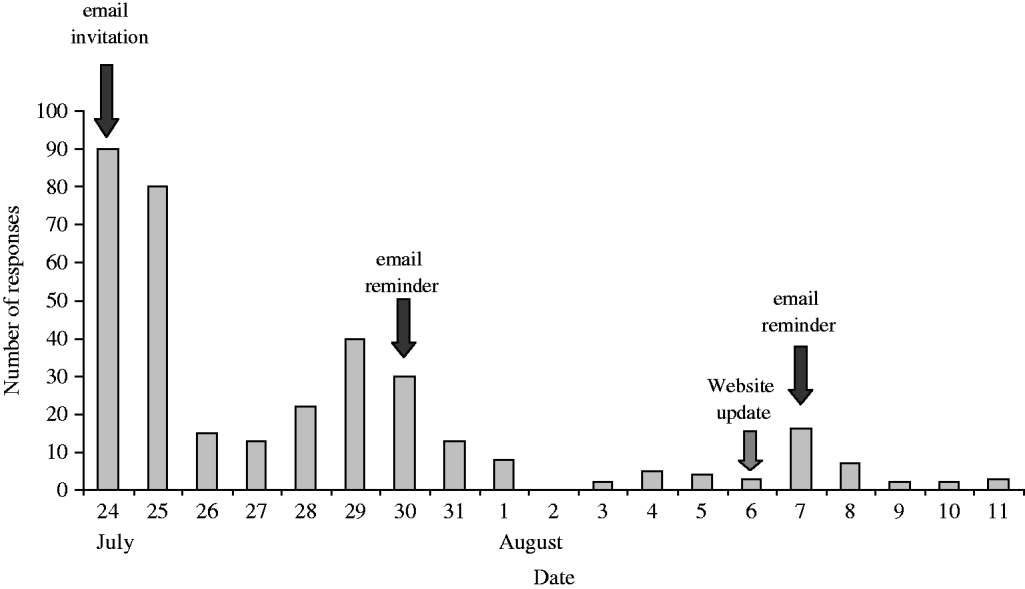
Fig. 1. Number of responses to internet questionnaire, by day, mountain-bike event, Mid Wales, 2008.
Descriptive epidemiology
Of those that responded, 29 participated in Saturday's events and 344 in Sunday's events. Of these, two participated only on Saturday and 318 only on Sunday. A total of 177 respondents reported that people travelled with them who did not participate in the event. The number of companions varied from 1 to 10.
The cohort comprised 299 males and 45 females (sex not recorded in three). The mean age was 37 years (minimum 17, maximum 63). The mean age for males was 37 years and for females 34 years. The predominance of males reflects that seen in the entrance to the event.
One hundred and sixty-one individuals (46·5%) reported that they had been ill following the event. The most frequently reported symptoms were tiredness (159), diarrhoea (151) and abdominal pain (131). Other symptoms included fever (94), nausea (91), vomiting (31) and blood in stool (15). Ten riders reported having stool samples which were positive for Campylobacter and one reported a ‘virus’. No other organisms were reported.
The attack rate in males was 47·5% and in females 37·8%. The difference was not statistically significant (P=0·22). Attack rates were higher in younger participants (Table 1), peaking in the 25–34 years age group. Analysis of attack rates by distance (Table 2) suggested those completing the longer events on Sunday tended to be at greater risk of illness. However, further analysis of attack rate by time on the course and feed stations used (not presented) failed to conclusively implicate specific areas of the courses. Only six of the travelling companions were reported to have been ill out of a total of 109 who answered this question (attack rate=5·5%).
Table 1. Attack rates by age group, gastrointestinal illness outbreak associated with a mountain-bike event, Mid Wales, 2008
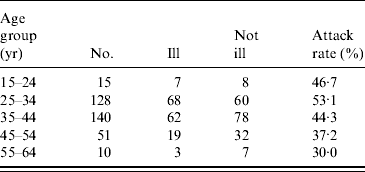
Table 2. Attack rates by day and event distance, gastrointestinal illness outbreak associated with a mountain-bike event, Mid Wales, 2008
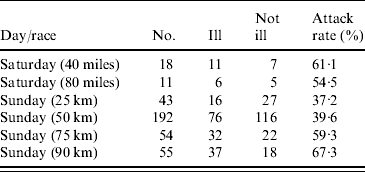
Self-reported onset of symptoms peaked between days 2 and 5 (median: day 3; range: days 0–15) (Fig. 2).
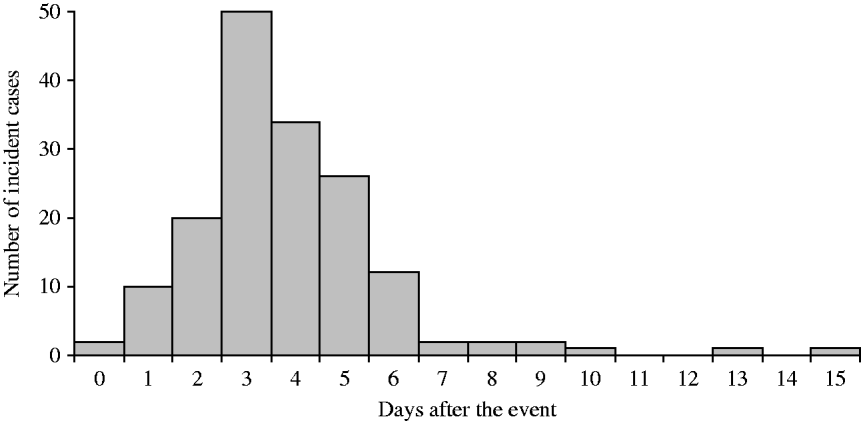
Fig. 2. Number of cases of gastrointestinal illness following mountain-bike event, Mid Wales, 2008.
Risk factor analysis
The results of the univariate analysis (Table 3) indicate that inadvertent ingestion of mud (RR 1·79, P<0·0001, AR 34·2%), drinking an energy drink from the feed station (RR 1·40, P=0·018, AR 22·7%), eating an energy bar from the feed station (RR 1·36, P=0·009, AR 16·1%) and eating ‘other food or drink’ during the event (RR 1·36, P=0·016, AR 7·5) were associated with being a case. The most commonly reported ‘other food and drink’ were energy bars and gels purchased before the event. Drinking from own frame-mounted bottle also presented a raised risk (RR 1·20) but this did not achieve significance (P=0·11, AR 7·7). Other in-event factors (drinking from a camel pack, drinking water from the feed station) did not present a statistically significant increased risk. Interestingly eating a banana from the feed station was associated with a reduced risk (RR 0·94), although this was not significant (P=0·62). No increased risk of illness was associated with residence at the camp site, eating from the food outlet or drinking mains water.
Table 3. Relative risks of exposures associated with a mountain-bike event, Mid Wales, 2008 (all entrants over the 2-day event)
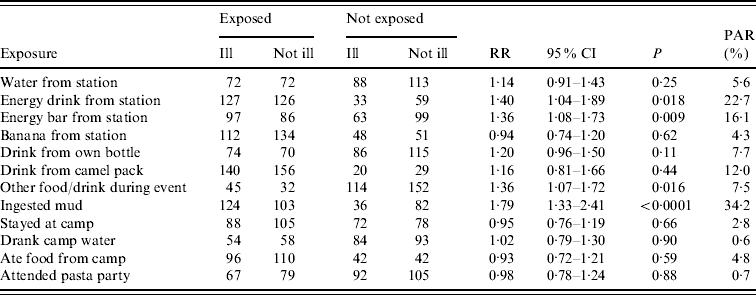
RR, Relative risk; CI, confidence interval; PAR, population attributable risk.
The four exposures which achieved significance in the univariate analysis were entered into a logistic regression along with single year of age and sex (Table 4). Only ingestion of mud and consumption of ‘other food or drink’ remained significant after controlling for other factors.
Table 4. Logistic regression of exposures identified as significant in the univariate analysis with single year of age and sex
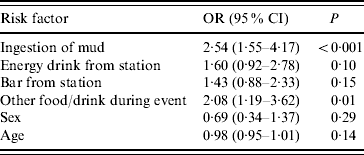
OR, Odds ratio; CI, confidence interval.
Overall results were not affected by the sensitivity analysis. The number of respondents who competed on Saturday (29) was too small for a robust analysis to be conducted.
DISCUSSION
Outcome of the investigation
Our results suggest that this was a point-source outbreak, confined to race participants, in which illness was associated with exposures which occurred during the race. Attack rates did not vary significantly with sex but were higher in younger participants. Existing immunity is likely to be a factor in this observation. Univariate analysis identified inadvertent ingestion of mud as the strongest association, a finding that was confirmed by logistic regression. Ingestion of a number of food and drink items was associated with increased risk of illness in the univariate analysis, a finding which is consistent with the widespread soiling of hands, equipment and utensils with mud. Although not statistically significant, eating bananas from the feed station was associated with a reduced risk, possibly due to the fact that they were eaten directly from their skins and so avoided contamination.
It is likely therefore, that heavy rain preceding the off-road event caused mud to form and mix with animal faeces on the course. The mud then acted as an efficient vehicle for pathogenic organisms contained within the animal faeces. Although microbiological confirmation has not been received for the majority of the symptomatic participants, our results are consistent with a point-source Campylobacter outbreak.
The OCT made a number of recommendations aimed at both organizers and riders. These included instructions not to serve open food at feed stations and suggestions to avoid the use of obviously contaminated food and drink containers. Provision of hand and bottle washing facilities was also suggested, as was course re-routing in the case of obvious animal faecal soiling. However, it is important to recognize that the nature of the terrain and the often remote locations may mean that such steps are difficult or impossible to implement. Such interventions therefore aim to reduce rather than eliminate the chance of illness. Mountain biking, along with many other sports conducted in the natural environment, involves a degree of risk. Zoonotic infection is one of these risks. Given that the acceptance of physical risk is necessary to participate in such sports, it is not clear how this additional microbiological risk would be perceived and whether food hygiene recommendations would be followed. This issue would benefit from further research. However, while many might discount the importance of this additional risk, organizers should raise awareness for the benefit of those who might be particularly affected by infective gastrointestinal disease such as the immunocompromised and food handlers.
The outcome of the investigation was fed back directly to the event organizers. The results were then disseminated to riders in a number of ways. An email summarizing the findings of the investigation and containing a link to the final report was sent to all individuals on the original mailing list [9]. This was supported by a press release which was circulated to both general and specialist biking media.
The nature of mountain biking as a sport means that riding across land used by both agricultural and wild animals is unavoidable and indeed desirable. The risk of infection from zoonotic organisms will therefore always be present. In this outbreak, the heavy overnight rain appears to have augmented the risk. This finding is not without precedence. Outbreaks of Escherichia coli O157 have been reported after a scout camp [Reference Howie10] and a music festival [Reference Crampin11], both of which were affected by heavy rain and held on land usually used by livestock. Muddy conditions were also linked with the campylobacteriosis outbreak associated with a mountain-bike event in Canada [Reference Stuart5]. Interestingly, the investigation of the 1998 Wisconsin Triathlon leptospirosis outbreak also blamed preceding heavy rain for causing heavier than usual contamination of the lake water, with a history of having swallowed lake water being identified as the greatest risk factor [Reference Morgan3].
The internet is still a relatively novel tool for conducting outbreak investigations, although its use is increasing [Reference Ghosh12–Reference Raupach and Hundy17]. This was our first experience of using the internet in this way and was prompted by the evident computer literacy of the event participants. In common with other authors we believe our work has demonstrated that efficiency and timeliness are the most significant strengths of the method [Reference Ghosh12, Reference de Jong and Ancker13, Reference Passaro, Scott and Dworkin15, Reference Kuusi16, Reference Castrodale18]. The use of email invitations and an internet-based questionnaire allowed us to rapidly and efficiently access the geographically dispersed population at minimal cost [Reference Rhodes, Bowie and Hergenrather19]. Automated data entry significantly reduced the time and resources needed to conduct the analysis and also reduced the chance of bias due to inaccurate data entry [Reference Rhodes, Bowie and Hergenrather19]. This resulted in the publication of a preliminary outbreak within 4 weeks of the first notification. The automatic download of response data allowed us to conduct a limited analyses of accommodation and catering exposures within 24 h of the questionnaire going live. The non-significant results linked to these exposures corroborated the results of the site inspections and helped reassure us that no ongoing risks were present. This interim analysis did not influence the design of the final analysis but it demonstrates that the internet method is also flexible in its application.
As with most field investigations, our work has a number of weaknesses. Our method clearly excluded those who do not have access to the internet. This may have caused selection bias by allowing over-representation of certain groups, for example younger people and those with greater educational attainment and computer literacy [Reference Kuusi16, Reference Castrodale18, Reference Rhodes, Bowie and Hergenrather19]. In our study, this is less likely to be a problem since it was evident that the majority of our population had internet access. However, it is true that only individuals with an electronically recorded email address were invited to participate. This decision was made to ensure that the investigation was conducted rapidly and with efficient use of resources, but meant that around 30% of entrants were not included in the study population. Although we have no data to suggest there is a systematic difference between these two groups, it is possible that this may have introduced a selection bias. For example, the decision to submit a paper entry form may be associated with age, which in turn would be associated with pre-existing immunity. However, we believe that such biases are unlikely to have significantly affected the results of our investigation due to both the size of the included population and also because the risk of being exposed is unlikely to have been associated with whether participants entered the event online or via a paper entry form.
Our conclusion about the likely responsible organism would have been strengthened if we had further microbiological evidence. The decision not to conduct any environmental sampling was taken since almost 2 weeks had elapsed by the time the outbreak was reported, by which time the faecal contamination was likely to have been dispersed. It was also felt that it would be difficult to identify which parts of the course should be tested and that, as no further events were planned, the value of environmental sampling was not clear. Similarly, although sampling of cases would have been desirable, testing of such a widely dispersed population would have been problematic. As the online questionnaire was completed anonymously, we were unable to verify any reported positive results or request samples on symptomatic individuals. Indeed many had recovered by the time the investigation began. None the less, the outbreak curve is consistent with an outbreak of Campylobacter, as are the most frequently reported symptoms. We are therefore confident that we have identified the likely responsible pathogen.
In common with many retrospective cohort studies, it is probable that those who were ill were more likely to respond and thus elevate attack rates. The response rate of 52·7% is also relatively low. While some investigators have managed to obtain higher response rates using internet-based methods, these have often, but not exclusively, been on relatively small, well defined or easily accessible groups [Reference Stuart5, Reference Ghosh12, Reference de Jong and Ancker13, Reference Raupach and Hundy17, Reference Castrodale18]. In contrast, other outbreak investigations involving larger community-based populations have obtained lower response rates than we achieved, with some as low as 11% [Reference Srikantiah14, Reference Passaro, Scott and Dworkin15]. Although it is therefore possible that we have obtained biased estimate of the risks in this outbreak, we believe that the numbers involved in our investigation are sufficiently large for the overall findings to be robust.
The case definition we chose to use was sensitive and so it is possible that individuals who were ill for other reasons may have been included as cases and caused biased estimates. However, if such misclassification bias did occur it is likely that it would result in a reduced effect size and so make the identification of significant risks less likely. However, even with this sensitive case definition, clear risks did emerge. Sensitivity analyses were conducted with more specific case definitions, but the results were very similar, suggesting that the effect of any misclassification was small.
All survey methods need to address issues of data protection, data security and confidentiality and need to discuss them openly with participants [Reference Castrodale18, Reference Rhodes, Bowie and Hergenrather19]. In our study, data were to be automatically entered onto a secure database which was housed within an NHS system. At the outset of our investigation we were concerned that public uncertainty about the security and confidentiality of electronic methods may have discouraged response to the survey. In view of this potential concern, we elected to allow questionnaires to be completed anonymously and did not collect any identifiable information. This decision meant that we were not able to establish a mechanism for ensuring that individuals did not completed the questionnaire more than once. The possibility of duplicate responses is a recognized problem of electronic survey methods, as is the possibility that invitations are forwarded to unintended respondents [Reference Castrodale18, Reference Rhodes, Bowie and Hergenrather19]. Although it is possible that individuals completed the questionnaire more than once, it is difficult to identify a motivation for such duplication in this situation. We therefore judged that the impact of this potential bias is negligible. Forwarding of emails is also unlikely to have caused a problem and may have been beneficial as it would have reached more of the target population.
CONCLUSION
This paper demonstrates how we successfully used the internet to conduct a rapid and efficient investigation of an outbreak of diarrhoeal illness associated with a mountain-bike event and to disseminate results.
We identified the inadvertent ingestion of mud as the exposure associated with the greatest risk of illness, concluding that it had acted as a vehicle of transmission and that Campylobacter was the likely responsible organism. It is clear that microbiological risks are an inherent part of such sports and ideally basic food hygiene should be followed in order to reduce the chance of illness. Organizers should alert riders to microbiological risks and, if possible, avoid using heavily contaminated land.
Using an internet survey proved to be an efficient, timely and flexible method and should be considered an essential tool for outbreak investigation. At present its use may be limited to more computer-literate populations, but increasing levels of internet access are likely to increase the number of accessible populations in the future.
ACKNOWLEDGEMENTS
We thank the event organizers for their cooperation with this investigation and their helpful feedback. We also thank Dr Mac Walapu (Consultant in Communicable Disease Control) and the many environmental health officers who contributed to the initial investigation. Finally, we thank Natalie Rees for her help in the administration of email invitations and Siân King for her assistance with literature searching.
DECLARATION OF INTEREST
None.







